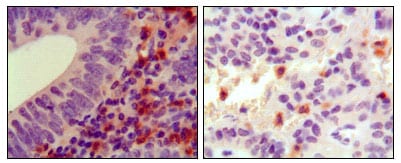
| WB | 1/500-1/2000 | Human,Mouse,Rat |
| IF | 咨询技术 | Human,Mouse,Rat |
| IHC | 咨询技术 | Human,Mouse,Rat |
| ICC | 技术咨询 | Human,Mouse,Rat |
| FCM | 咨询技术 | Human,Mouse,Rat |
| Elisa | 1/5000-1/10000 | Human,Mouse,Rat |
| Aliases | JTK9 |
| Entrez GeneID | 3055 |
| clone | 3D12E10 |
| Host/Isotype | Mouse IgG1 |
| Antibody Type | Primary antibody |
| Storage | Store at 4°C short term. Aliquot and store at -20°C long term. Avoid freeze/thaw cycles. |
| Species Reactivity | Human |
| Immunogen | Purified recombinant fragment of HCK expressed in E. Coli. |
| Formulation | Ascitic fluid containing 0.03% sodium azide. |
+ +
以下是关于ZBTB16抗体的3篇参考文献示例,包含文献名称、作者及摘要概括:
---
1. **文献名称**:*ZBTB16 maintains progenitor cells in the hematopoietic niche by regulating mTORC1*
**作者**:Chen S, et al.
**摘要**:该研究通过Western blot和免疫组化(使用ZBTB16抗体)发现,ZBTB16通过抑制mTORC1信号维持造血干细胞自我更新,缺失ZBTB16会导致小鼠造血干细胞耗竭。
2. **文献名称**:*PLZF/ZBTB16 regulates the development of human T-cell acute lymphoblastic leukemia*
**作者**:Ramos-Mejía V, et al.
**摘要**:利用ZBTB16抗体进行流式细胞术和ChIP-seq分析,揭示ZBTB16在T细胞急性淋巴细胞白血病(T-ALL)中的致癌作用,其通过调控Notch信号通路促进白血病细胞增殖。
3. **文献名称**:*ZBTB16 modulates the senescence-associated secretory phenotype in stromal fibroblasts*
**作者**:Kim J, et al.
**摘要**:研究通过免疫荧光(使用ZBTB16抗体)和RNA-seq证明,ZBTB16在衰老的基质成纤维细胞中表达上调,并激活促炎细胞因子分泌,可能促进肿瘤微环境重塑。
---
以上文献均以ZBTB16抗体为实验工具,探讨其在干细胞、癌症及衰老中的分子机制。如需具体DOI或期刊信息,可补充说明进一步检索。
The ZBTB16 antibody is a crucial tool in studying the ZBTB16 protein, a zinc finger transcription factor encoded by the ZBTB16 gene (also known as PLZF or promyelocytic leukemia zinc finger). ZBTB16 contains a BTB/POZ domain at its N-terminus, which mediates protein-protein interactions, and multiple C2H2 zinc finger motifs at the C-terminus for DNA binding. It functions as a transcriptional repressor, regulating cell differentiation, proliferation, and apoptosis. ZBTB16 is notably involved in hematopoiesis, neurogenesis, and maintaining stem cell pluripotency. Its role in cancer is context-dependent: while it acts as a tumor suppressor in acute promyelocytic leukemia (APL) due to its fusion with RARA in chromosomal translocations, it may promote oncogenesis in other cancers like prostate cancer.
ZBTB16 antibodies are widely used in techniques such as Western blotting (WB), immunohistochemistry (IHC), and chromatin immunoprecipitation (ChIP) to detect protein expression, localization, and DNA-binding activity. These antibodies target specific epitopes, often within the BTB or zinc finger domains, and are available in monoclonal or polyclonal forms from various host species (e.g., rabbit, mouse). Researchers rely on ZBTB16 antibodies to explore its interactions with co-repressors (e.g., NCOR, HDACs) and its regulatory roles in signaling pathways like Wnt and Hedgehog. Dysregulation of ZBTB16 has been linked to developmental disorders and malignancies, making its antibody a key reagent in both basic research and clinical diagnostics. Validation via knockout controls or peptide blocking ensures specificity, particularly given structural similarities among BTB-ZF family members.
×